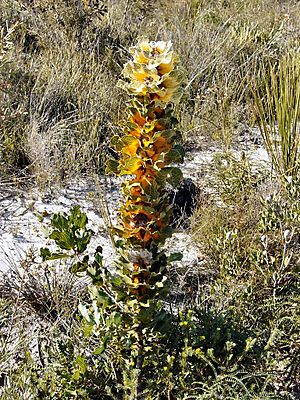Royal hakea facts for kids
Quick facts for kids Royal Hakea |
|
|---|---|
 |
|
| Hakea victoria in the Fitzgerald River National Park | |
| Scientific classification | |
| Genus: |
Hakea
|
| Species: |
victoria
|
The Royal Hakea (also called lantern hakea) is a special type of shrub. Its scientific name is Hakea victoria. This plant grows only in Western Australia, which means it is endemic there. People love it because its leaves are very colorful and unique. The Noongar people, who are the traditional owners of the land, call this plant Tallyongut.
Contents
Discover the Royal Hakea
What Does It Look Like?
The Royal Hakea grows straight up and is quite slender. It can reach a height of about 1 to 3 meters (3 to 10 feet) and be about 1 meter (3 feet) wide. It does not have many branches. This plant does not form a lignotuber, which is a woody swelling at the base that helps some plants regrow after a fire.
Its leaves are arranged one after another along the stem. They have clear veins on both the top and bottom. Each leaf is usually 4 to 11.5 centimeters (1.5 to 4.5 inches) long and 4 to 13 millimeters (0.15 to 0.5 inches) wide. The leaves feel rough and leathery. Their edges are wavy with sharp, prickly teeth, and they end in a sharp point.
The lower leaves are green and narrow. However, the leaves higher up are broad and curved like a cup. These upper leaves are yellow at the bottom and gradually turn green towards the tip. This makes the plant look like it has colorful lanterns, which is why it's also called "lantern hakea."
Flowers and Fruits
The Royal Hakea has small flowers that grow in groups of 26 to 42. These flowers are cream-white, red, or pink. They grow where the leaves meet the stem, and the unique leaf shape almost hides them. The flower stalk, called a pedicel, is smooth and about 6 to 11 millimeters long. The female part of the flower, the pistil, is about 33 to 37 millimeters long. The outer parts of the flower, called the perianth, are cream-colored.
This plant usually blooms from June to October. After the flowers, it produces woody fruits. These fruits are about 25 millimeters (1 inch) long and 15 to 20 millimeters (0.6 to 0.8 inches) wide.
How the Royal Hakea Got Its Name
The first Royal Hakea plant was found near West Mount Barren in Western Australia. A botanist named James Drummond collected it in 1847. He was the first to describe this plant in a newspaper called The Inquirer.
The plant's scientific name, victoria, was chosen to honor Queen Victoria. This name was given by a naturalist named John Gilbert.
Where Does the Royal Hakea Live?
The Royal Hakea grows in sandy areas that contain quartzite or lateritic soil. It prefers rocky places near the coast. You can find it in the region between Albany and Esperance in Western Australia. A great place to see it is in the Fitzgerald River National Park.
Growing Your Own Royal Hakea
If you want to grow a Royal Hakea, it needs a sunny spot with soil that drains water well. It can handle a little bit of frost. However, it does not like places that are very humid (moist air). If it's too humid, the plant might not survive, or its beautiful colorful leaves won't look as vibrant.
It's easy to grow new plants from seeds. But trying to grow them from cuttings (pieces of the plant) is quite difficult.

